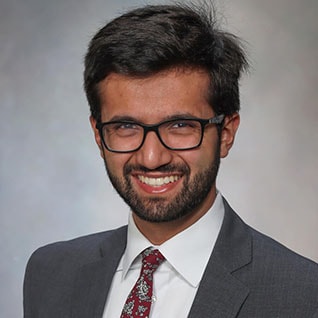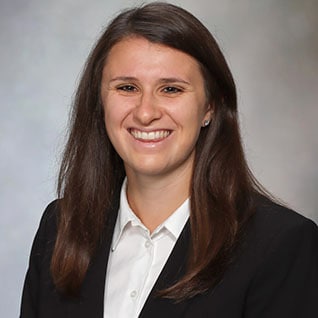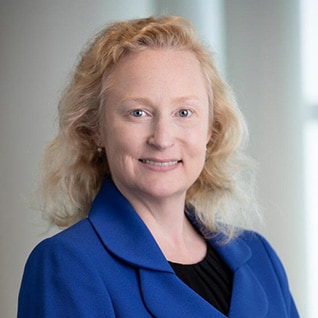/prod01/channel_2/media/mccms/content-assets/about/news/sept-dec-2023/1024X512_Inernal-med-practice-WF3026754_0028.jpg)
November 29, 2023
This year's National Resident Matching Program brought nearly 350 new residents to Mayo Clinic campuses, where they began three- to seven-year commitments. More than two dozen of the new residents are graduates of Mayo Clinic Alix School of Medicine. A few of our new residents share their path to Mayo.
The new residents and fellows join one of the oldest and largest graduate medical education institutions in the country. By the numbers, the School of Graduate Medical Education includes:
- More than 1,900 residents.
- Nearly 350 medical and surgical programs at Mayo Clinic in Arizona, Florida, Rochester, and Mayo Clinic Health System.
- A total of 197 Accreditation Council for Graduate Medical Education-accredited residency and fellowship training programs, making the school the largest sponsoring program in the U.S.
Unique opportunities led new residents to Mayo Clinic
Learn about two residents and a program director at Mayo Clinic in Florida.
 Faaiq Aslam, M.D.
Faaiq Aslam, M.D.
Faaiq Aslam, M.D., has ties to Mayo Clinic that go back to high school. He volunteered at Mayo as a high school student, and he attended medical school at Mayo Clinic Alix School of Medicine.
Now, Dr. Aslam is a new resident in internal medicine at Mayo Clinic in Florida.
"I saw the culture and the values that Mayo had and how different they were from other places. It was really eye-opening to see the emphasis placed on the needs of the patient and how important the patient was in regard to driving how care was delivered," he says.
In his first month of rotations, Dr. Aslam was on hospital service treating a complex patient. He relished the opportunity not only to provide her with the best care but also to take time to speak with the patient and her family, and talk through their concerns and their stress.
One thing that Dr. Aslam particularly appreciates about his training program is the generous amount of elective time. He is interested in interventional cardiology, and the first-year internal medicine program allows for plenty of elective time to learn about subspecialties.
"Our class sizes in Florida are small. It really allows you to get to know your mentors so well. They can guide you and are willing to give you unique opportunities," he says.
Unique programming and unparalleled opportunities led many members of the new resident class to rank Mayo at the top of their list during National Resident Matching Program.
 Krista Grennan, M.D.
Krista Grennan, M.D.
Krista Grennan, M.D., knew Mayo Clinic School of Graduate Medical Education was the place for her after interviewing and learning that her program director has a strong interest in service learning for residents. As a first-year internal medicine resident at Mayo Clinic in Florida, Dr. Grennan has a passion for service learning and is excited that third-year residents in the program act as sub-attendings and have the opportunity to teach.
With the support of her program director Mary Hedges, M.D., Dr. Grennan now serves on the medical school education subcommittee, which helps address pertinent medical school topics such as coordinating mentorships, evaluations, events, and curriculum on the Florida campus. Dr. Grennan was involved in teaching and mentoring during her undergraduate and medical school years, and she is looking forward to growing her experience while on her way to a career in medical education.
"I couldn't have asked for a better residency experience than what I've had so far," she says. "Mayo has done everything to make my transition as smooth as possible."
Dr. Grennan has already submitted a case report with the support of an attending physician. She hopes to publish it and be able to present it at a conference.
"Dr. Hedges has explored how to make it even easier for first-year residents to get connected with research mentors by creating a research database on the Mayo Intranet," Dr. Grennan says.
 Mary Hedges, M.D.
Mary Hedges, M.D.
Dr. Hedges, whose own residency at Mayo Clinic began 20 years ago, is proud of the progress her program has made in bridging medical education with innovation. Florida's internal medicine program has an associate program director specifically dedicated to innovation, fostering a strong mentorship model between residents and faculty, resulting in abundant research opportunities, even in the first year.
Beyond the classroom or the laboratory, Dr. Hedges has prioritized a commitment to serving the underserved through Mayo Clinic School of Graduate Medical Education. Residents in her program don't just deliver medical care to underserved patients in the community as a volunteer service — it's part of the curriculum. Strengthening residents' ties to the community is important for Dr. Hedges, who notes that about 50% of her trainees stay within Mayo Clinic after completing their training.
"Everyone understands that education, and graduate medical education specifically, represents our workforce of the future," Dr. Hedges says. "We're not only training physicians, but we're training them the Mayo way, which is unique. We're setting them up to be successful within the Mayo system, which is itself a very successful system."
Dr. Hedges adds that when matching residents to her program, she thinks of it as matching clinicians and faculty of the future, and it's a responsibility she doesn't take lightly.
"This is a rockstar class," she says. "They are an incredibly diverse class, and not just race and gender diversity but diversity of experience, diversity of background, of education, geographical diversity, and they all bring something very special to the table."
More than a century after the Mayo brothers began teaching the Mayo Model of Care and providing specialty training to graduate physicians, residents are still learning to deliver patient care the Mayo Clinic way.